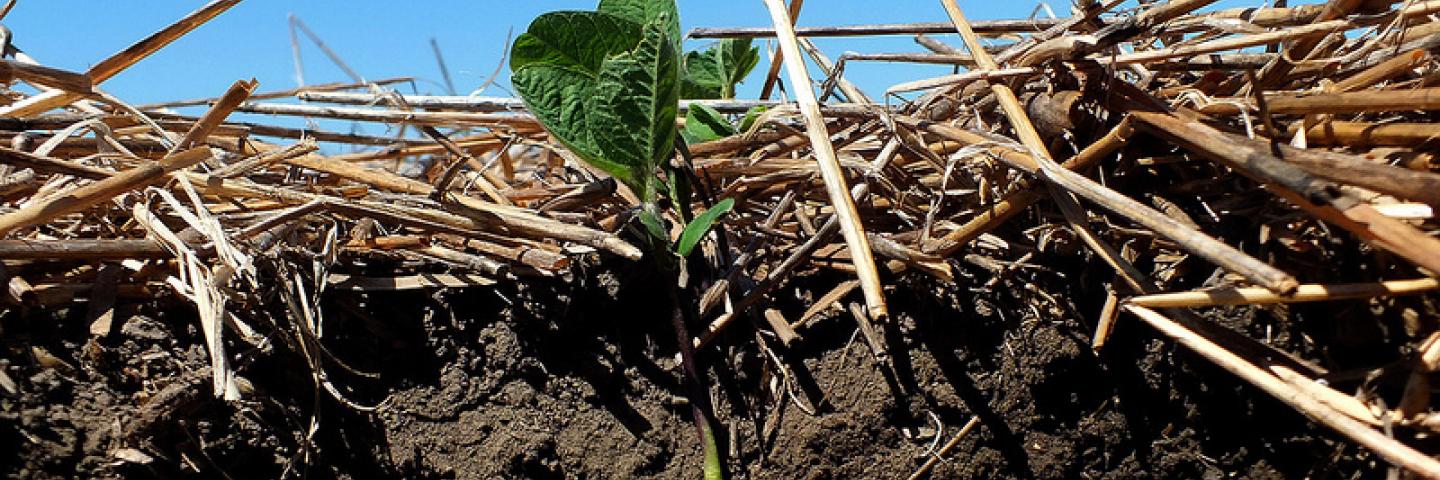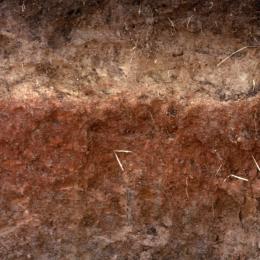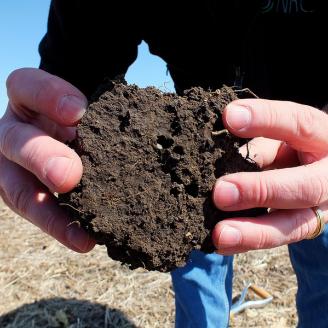
This site contains information about the Soil Survey program in Arkansas.
"Stuttgart" the Arkansas State Soil

Stuttgart soils are named for the city of Stuttgart in Southeast Arkansas. They are used primarily for cropland with the dominant crops being rice, soybeans, small grains, and corn. The Stuttgart area is famous for its large fall and winter population of ducks and geese. These waterfowl feed heavily on the crops grown on the Stuttgart soils. Stuttgart soils have been mapped on about 200,000 acres in Arkansas. The Stuttgart series consists of very deep moderately well to somewhat poorly drained soils formed in silty and clayey alluvium. These level to gently sloping soils are on Prairie terraces in the Lower Mississippi Valley. Stuttgart's silt loam surface texture and the slow permeability in its clayey subsoil makes the soil ideal for rice population.
Typical Stuttgart Soil Profile
Surface: 0 to 11 inches - dark grayish brown and grayish brown silt loam
Subsurface: 11 to 23 inches - yellowish brown silt loam
Subsoil: 23 - 35 inches - red silty clay; 35 - 80 inches - grayish brown and light brownish gray silty clay loam
Soil Family Classification
Fine, smectitic, thermic Albaquultic Hapludalfs
Stuttgart soils are in the Alfisols soil order. Alfisols are mostly soils of intermediate age. The "Albaquultic" subgroup implies that the soil has an abrupt textural change, has a moderately high water table during part of the year, and that the base saturation is less than 60 percent at 50 inches below the top of the subsoil. The term "fine" indicates that the upper subsoil averages between 35 and 60 percent clay. The term "smectitic" implies that the clay in the subsoil is dominated by minerals that expand upon wetting and contract upon drying. "Thermic" refers to an average annual soil temperature of between 15o to 22oC (59o to 72oF).
Soil Health
Soil health, also referred to as soil quality, is defined as the continued capacity of soil to function as a vital living ecosystem that sustains plants, animals, and humans. This definition speaks to the importance of managing soils so they are sustainable for future generations. To do this, we need to remember that soil contains living organisms that when provided the basic necessities of life - food, shelter, and water - perform functions required to produce food and fiber.
Only "living" things can have health, so viewing soil as a living ecosystem reflects a fundamental shift in the way we care for our nation's soils. Soil isn’t an inert growing medium, but rather is teaming with billions of bacteria, fungi, and other microbes that are the foundation of an elegant symbiotic ecosystem. Soil is an ecosystem that can be managed to provide nutrients for plant growth, absorb and hold rainwater for use during dryer periods, filter and buffer potential pollutants from leaving our fields, serve as a firm foundation for agricultural activities, and provide habitat for soil microbes to flourish and diversify to keep the ecosystem running smoothly.
Learn more about how Soil Biology plays a major role in soil health.
What Soil Does
Healthy soil gives us clean air and water, bountiful crops and forests, productive grazing lands, diverse wildlife, and beautiful landscapes. Soil does all this by performing five essential functions:
- Regulating water - Soil helps control where rain, snowmelt, and irrigation water goes. Water and dissolved solutes flow over the land or into and through the soil.
- Sustaining plant and animal life - The diversity and productivity of living things depends on soil.
- Filtering and buffering potential pollutants - The minerals and microbes in soil are responsible for filtering, buffering, degrading, immobilizing, and detoxifying organic and inorganic materials, including industrial and municipal by-products and atmospheric deposits.
- Cycling nutrients - Carbon, nitrogen, phosphorus, and many other nutrients are stored, transformed, and cycled in the soil.
- Physical stability and support - Soil structure provides a medium for plant roots. Soils also provide support for human structures and protection for archeological treasures.
Inherent and Dynamic Properties of Soil
Soil has both inherent and dynamic properties, or qualities. Inherent soil quality is a soil’s natural ability to function. For example, sandy soil drains faster than clayey soil. Deep soil has more room for roots than soils with bedrock near the surface. These characteristics do not change easily.
Dynamic soil quality is how soil changes depending on how it is managed. Management choices affect the amount of soil organic matter, soil structure, soil depth, and water and nutrient holding capacity. One goal of soil health research is to learn how to manage soil in a way that improves soil function. Soils respond differently to management depending on the inherent properties of the soil and the surrounding landscape.
Understanding soil health means assessing and managing soil so that it functions optimally now and is not degraded for future use. By monitoring changes in soil health, a land manager can determine if a set of practices is sustainable. See Soil Health Assessment and Soil Health Management principles for soil health for more information.
Additional Information
Arkansas's Healthy Land and Waters - Naturally Campaign
National Soil Health Awareness Web site
Soil Surveys
County Soil Surveys of Arkansas available are listed below.
For a copy of a soil survey, please click here Soil Survey Request.
Your request should be filled within one week.
Surveys marked with (CD) are available on CD as Adobe PDFs.
Arkansas - 2005 (CD)
Crittenden - 1974
Lafayette, Little River & Miller - 1984
Pope - 1981
Ashley - 1979 (CD)
Cross (CD)
Lawrence - 1978
Pulaski - 1975
Baxter & Marion - 1983
Desha - 1972 (CD)
Lee - 1977
Randolph - 1980
Benton - 1977 (CD)
Drew - 1976 (CD)
Logan - 1980
St. Francis - 1966
Boone - 1981
Faulkner - 1979
Lonoke & Prairie - 1981
Saline - 1979
Calhoun & Dallas - 1980
Franklin - 1971
Madison - 1986
Scott - 1998
Carroll - 1984
Fulton & Izard - 1984
Mississippi - 1971
Searcy - 1992
Chicot - 1967
Garland - 1989
Monroe - 1978
Sebastian - 1975 (CD)
Clark & Hot Spring - 1987
Greene - 2006 (CD)
Nevada - 2007 (CD)
Sharp - 1984
Clay - 1978
The following Soil Survey Manuscripts are available on-line on the NRCS National Soils site at http://soils.usda.gov/.
Arkansas - 2005
Crawford - 1980
Lafayette, Little River & Miller - 1984
Pope - 1981
Ashley - 1979
Cross
Madison - 1986
Scott - 1998
Baxter & Marion - 1983
Desha - 1972
Miller
Searcy - 1992
Benton - 1977
Drew - 1976
Montgomery - 2007
Sebastian - 1975
Boone - 1981
Garland - 1989
Nevada - 2007
Sharp - 1984
Bradley
Grant
Newton - 1988
Union - 2006
Carroll - 1984
Greene - 2006
Perry - 1982
Washington - 1969
Chicot - 1967
Hempstead - 1979
Phillips - 1974
White - 1982
Cleveland - 1968
Independence - 1982
Polk - 2003
Woodruff - 2002
Columbia - 1985
Counties that are not available as hard copies are:
Bradley - 1961 (CD) - out of print
Cleveland -1968 (CD) - out of print
Grant - in progress
Pike - in progress
Sevier - in progress
Washington - 1969 (CD) - out of print
Hempstead - 1979 (CD)
Newton - 1988
Stone - 1983
Cleburne & Van Buren - 1986
Howard - 1975
Ouachita - 1973
Union - 2006 (CD)
Columbia - 1985
Independence - 1982 (CD)
Perry - 1982
White - 1982
Conway - 1980
Jackson - 1974
Phillips - 1974
Woodruff - 2002 (CD)
Craighead - 1980
Jefferson & Lincoln - 1981
Poinsett - 1977
Yell - 1989
Crawford - 1980 (CD)
Johnson - 1977
Polk - 2005 (CD)


